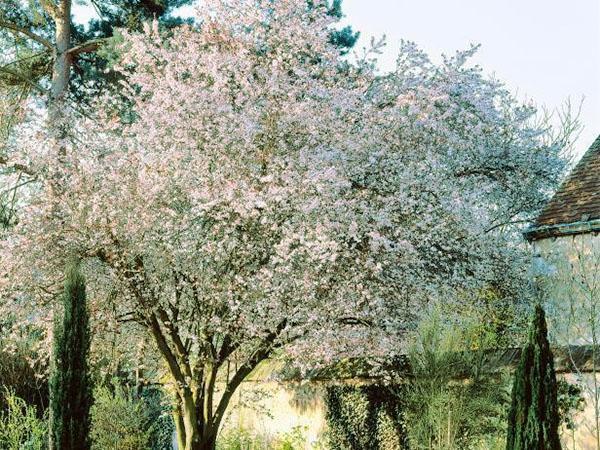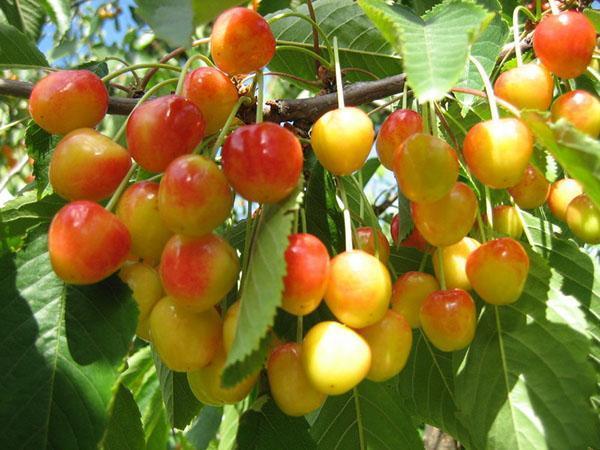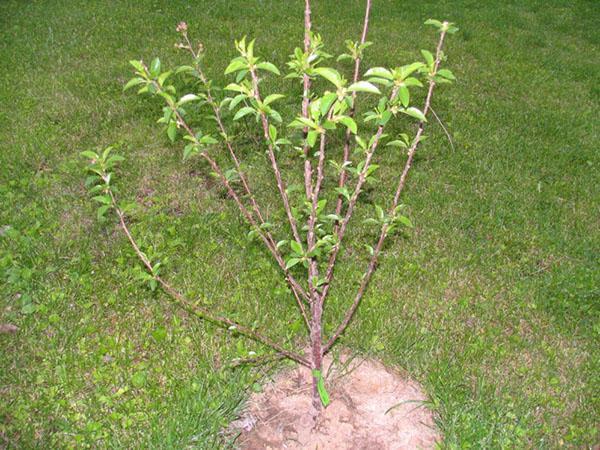Sweet cherry for the Moscow region - the best varieties of the middle zone of agriculture
 In festive decoration, sweet cherry is the best variety for the Moscow region, a messenger of the onset of stable heat. The southerner did not take root for a long time in the middle lane - delicate flower buds and young branches froze over. Repeated attempts to create stable forms invariably ended in failure. In the middle of the last century, in three regions with a mild climate, based on previously obtained. IV Michurin forms, managed to bring out several varieties of capricious "Bird cherry". This is the name of the sweet cherry in the south, where the drupes were carried by the birds. As a result of long-term work of breeders, the best varieties of sweet cherries for the Moscow region of Bryansk, Oryol and Moscow selection have appeared.
In festive decoration, sweet cherry is the best variety for the Moscow region, a messenger of the onset of stable heat. The southerner did not take root for a long time in the middle lane - delicate flower buds and young branches froze over. Repeated attempts to create stable forms invariably ended in failure. In the middle of the last century, in three regions with a mild climate, based on previously obtained. IV Michurin forms, managed to bring out several varieties of capricious "Bird cherry". This is the name of the sweet cherry in the south, where the drupes were carried by the birds. As a result of long-term work of breeders, the best varieties of sweet cherries for the Moscow region of Bryansk, Oryol and Moscow selection have appeared.
Biological characteristics of the sweet cherry fruit tree

A two-year-old seedling is planted, necessarily grafted. The soil for a young plant needs light, fertilized and neutral reaction. The tree is placed on a southern or eastern slope, with good wind protection. The groundwater should be very deep, and surface irrigation should be regular, preferably drip. The best varieties of cherries zoned for the Moscow region can be purchased at the Moscow nursery for nature testers.
The methods of radiation and chemical mutagenesis have accelerated the production of new varieties. Breeder Evstratov exposed the planting material to gamma irradiation and used biological stimulants. As a result, some of the new varieties withstood a drop in temperature to -30 degrees in state tests, acquired early maturity, and resistance to perforated spotting. Active growth in summer quickly restores the crown after winter frostbite.
Of the newly created and earlier varieties of cherries for the Moscow region, there are no self-fertile ones. One tree can only be planted for decorative purposes. There must be a couple of different varieties. But in cramped conditions, you can plant a pollinator in the crown of the main tree on separate branches around the perimeter.
You can grow a seedling from a cherry seed, but then vaccinate. The formation of the bush begins from the first year of the growing season. Agrotechnical activities are carried out as for other Pinks. Consider the best cherry varieties for central Russia, their advantages.
The best varieties of cherries
 An excellent variety of early ripening will bestow about 6 grams of dark-burgundy, almost black berries. The pulp is juicy, dark-colored, the stone is small. A tall tree, about 4 meters tall, blooms in the first decade of May, the fruits ripen in mid-June. The variety is frost-resistant, well endured the extreme winters of 1995-1997 in the Bryansk region. Annual fruiting, moderate from the fifth year. The shape of the tree is pyramidal. Fungal diseases are not terrible for Iput cherries. The berries tolerate transportation well and are used for making compotes. The Fatezh variety will be a good pollinator neighbor.
An excellent variety of early ripening will bestow about 6 grams of dark-burgundy, almost black berries. The pulp is juicy, dark-colored, the stone is small. A tall tree, about 4 meters tall, blooms in the first decade of May, the fruits ripen in mid-June. The variety is frost-resistant, well endured the extreme winters of 1995-1997 in the Bryansk region. Annual fruiting, moderate from the fifth year. The shape of the tree is pyramidal. Fungal diseases are not terrible for Iput cherries. The berries tolerate transportation well and are used for making compotes. The Fatezh variety will be a good pollinator neighbor.
 An elegant tree, strewn with maroon, slightly elongated bunches of berries, yields late, in mid-July. Cherry Revna belongs to self-pollinated varieties, abundant annual fruiting. The berries are dense, juicy, stored during transportation for a long time.
An elegant tree, strewn with maroon, slightly elongated bunches of berries, yields late, in mid-July. Cherry Revna belongs to self-pollinated varieties, abundant annual fruiting. The berries are dense, juicy, stored during transportation for a long time.
Sweet cherry grows rapidly, reaching 3.5 meters, pyramidal shape, oval leaves. Cherry begins to bear fruit for 4 years. Cherry Revna is frost-resistant, not susceptible to perforated spots and other crown diseases. The yield increases if a girlfriend grows nearby.
 Cherry Fatezh was bred quite recently, but showed the best qualities in terms of yield and fruit taste among all varieties of the middle strip. A medium-sized bright red berry ripens in early July. On the red background of the fruit, yellow specks are scattered - a gift from the Leningradskaya yellow variety. The taste of the fruit is estimated by the tasters at 4.7 points.
Cherry Fatezh was bred quite recently, but showed the best qualities in terms of yield and fruit taste among all varieties of the middle strip. A medium-sized bright red berry ripens in early July. On the red background of the fruit, yellow specks are scattered - a gift from the Leningradskaya yellow variety. The taste of the fruit is estimated by the tasters at 4.7 points.
Excellent winter hardiness has moved the cherry further north. The tree has a spherical sparse crown, grows up to 4 meters, and begins bearing fruit in the fifth year. Fatezh cherry blossoms begin in mid-May. The self-fertile variety needs a pollinator. Chermashnaya, Sinyavskaya or Crimean cherries are planted in pairs. Tests show a stable yield of an adult tree for 4 years at 16 kg.
The advantages of the variety include resistance to diseases, tolerance with a periodic lack of watering. The tree must be protected from the wind - it does not tolerate.
 Cherry Tyutchevka belongs to late-ripening varieties. A tree of medium height, with a lush spherical crown, winter-hardy, resists perforated spotting. Self-fertility of cherries is considered a great advantage. Fruiting occurs 5 years after planting.
Cherry Tyutchevka belongs to late-ripening varieties. A tree of medium height, with a lush spherical crown, winter-hardy, resists perforated spotting. Self-fertility of cherries is considered a great advantage. Fruiting occurs 5 years after planting.
The berries are large, up to 7 grams, round, burgundy with black subcutaneous dots. The pulp has a pleasant taste, red color, medium stone, easy to separate.
Annual high yields are one of the main features of the Tyutchevka variety.
 Sweet cherry Bryanskaya Rosovaya, the brainchild of Bryansk breeders Kanshina and Astakhov, was selected as promising for the middle lane following a strict requirement for endurance. Large pink berries have a pleasant taste. The variety is late-ripening, blooms in mid-May, ready for harvesting in the second decade of July. Fruiting is regular, fruits are stable during transportation, do not crack. Ripe fruits do not rot in rainy weather.
Sweet cherry Bryanskaya Rosovaya, the brainchild of Bryansk breeders Kanshina and Astakhov, was selected as promising for the middle lane following a strict requirement for endurance. Large pink berries have a pleasant taste. The variety is late-ripening, blooms in mid-May, ready for harvesting in the second decade of July. Fruiting is regular, fruits are stable during transportation, do not crack. Ripe fruits do not rot in rainy weather.
The tree is compact, grows 2.5 m, the crown is sparse, the leaves are large. The advantages of the variety are its frost resistance and protection from putrefactive, bacterial diseases.
 Cherry Krymskaya does not have outstanding fruit qualities, but it is the best pollinator for self-fruitless varieties of sweet cherry. The fruits are small, with the astringency of bird cherry, they make an excellent wine. The variety is winter-hardy, bred and tested in the Kursk, Tula, Moscow regions. Why they called it Crimean is a mystery from the author.
Cherry Krymskaya does not have outstanding fruit qualities, but it is the best pollinator for self-fruitless varieties of sweet cherry. The fruits are small, with the astringency of bird cherry, they make an excellent wine. The variety is winter-hardy, bred and tested in the Kursk, Tula, Moscow regions. Why they called it Crimean is a mystery from the author.
 Sweet cherry Orlovskaya pink surpasses all varieties in frost resistance. After a frost test of 37.5 degrees, the tree continued to bear fruit. The variety is fast-growing, the first harvest gives in the fourth year after planting. Orlovskaya pink is self-fertile, pollinators can be varieties blooming in mid-May - Rechitsa, Pink Pearl. Average yield per tree is 10 kg, fruits weigh about 6 grams.
Sweet cherry Orlovskaya pink surpasses all varieties in frost resistance. After a frost test of 37.5 degrees, the tree continued to bear fruit. The variety is fast-growing, the first harvest gives in the fourth year after planting. Orlovskaya pink is self-fertile, pollinators can be varieties blooming in mid-May - Rechitsa, Pink Pearl. Average yield per tree is 10 kg, fruits weigh about 6 grams.
The variety is resistant to perforated spotting.
Science does not stand still, research and experiments continue. New varieties are undergoing trials and have excellent prospects. You can get their seedlings at test stations, but you will need to keep a diary of plant development to help scientists get the best hardy and tasty cherries for the Moscow region.